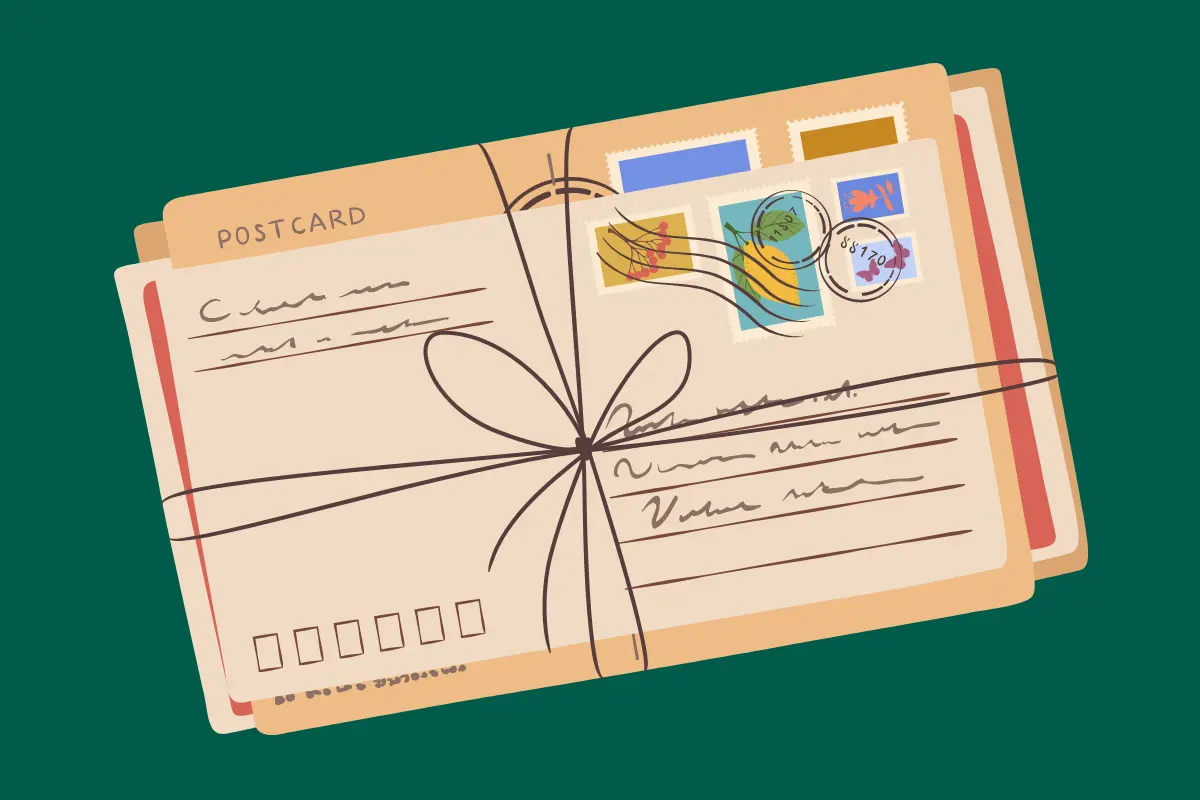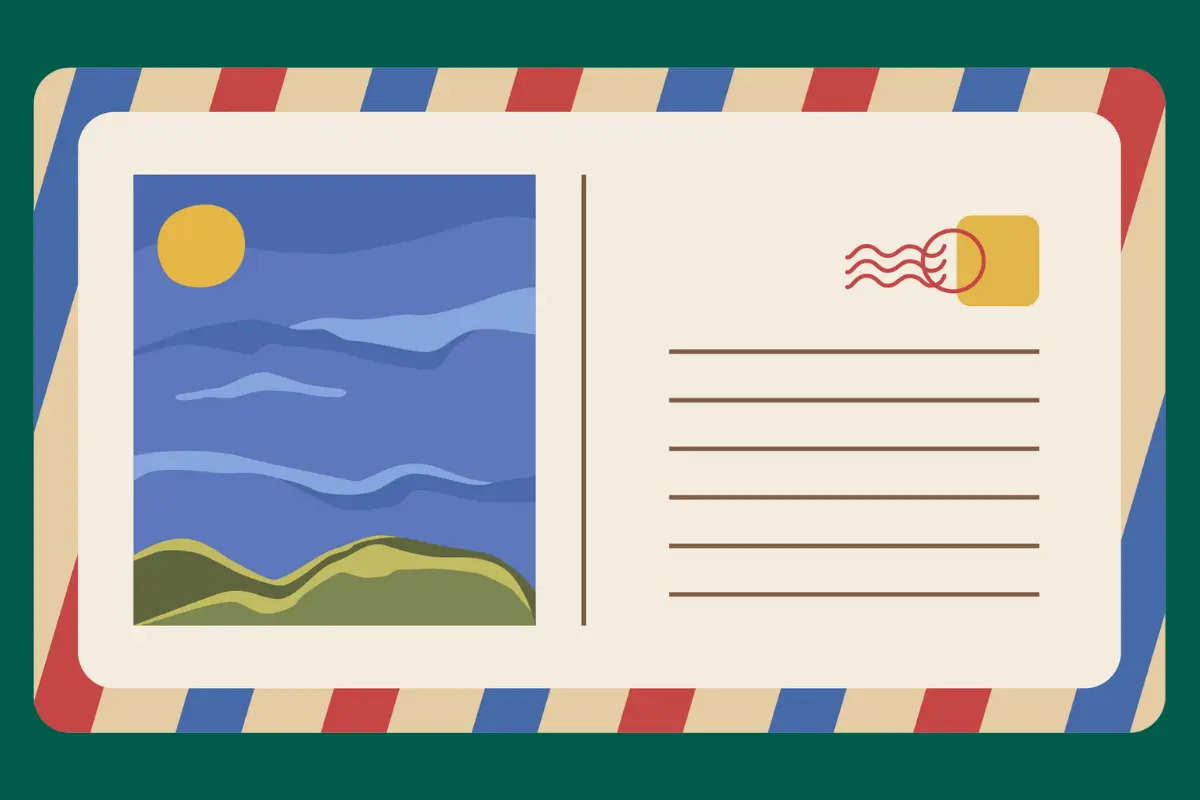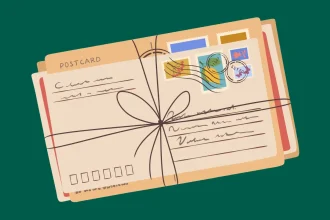How to Write a Postcard: 7 Tips, Examples & Perfect Messages
In this article, you'll learn how to write a postcard with 7 essential tips and practical examples. Discover how to create memorable messages and make your postcards stand out. Start mastering postcard writing today!

Murad Khan
Last updated on Sep 18th, 2024

When you click on affiliate links on QuillMuse.com and make a purchase, you won’t pay a penny more, but we’ll get a small commission—this helps us keep up with publishing valuable content on QuillMuse. Read More.
Table of Contents
Writing a postcard is an art that has been cherished for generations. Despite the rise of digital communication, postcards remain a personal, tangible way to stay connected. Whether you’re traveling, celebrating an event, or simply sending a note to a friend, postcards capture a moment in time with brevity and charm. This guide will walk you through the steps, tips, and examples of how to write a postcard effectively.
What is a Postcard?
A postcard is a small, flat card, typically rectangular, that is used to send short messages by mail without the need for an envelope. Postcards usually have a design or photograph on one side, which may depict anything from famous landmarks, art, or personal photos, while the other side is reserved for a message, address, and postage.
Postcards are often used for casual correspondence, particularly when traveling, as they provide a quick and personal way to share experiences and greetings. They’re also popular for special occasions, holidays, or just to send a short, thoughtful message to a friend or loved one.
Read more: How to Write a Letter
Why Write a Postcard?
In an era dominated by instant messaging, emails, and social media, writing a postcard offers a unique form of communication. Here are a few reasons why you might choose to send a postcard:
- Personal Touch: A postcard feels more personal and thoughtful than a text or email.
- Tangible Memory: Postcards are physical keepsakes that recipients can keep and display.
- Expressing Creativity: From selecting the postcard design to crafting a short message[1], postcards allow for creativity.
- Cultural Significance: Sending postcards from new places is a time-honored tradition, offering a glimpse of a different culture or destination.
Choosing the Right Postcard
Before you write, the first step is selecting the perfect postcard. Here are some things to consider when making your choice:
- Purpose of the Postcard
- Travel Postcards: Postcards featuring landmarks or cultural aspects of the place you’re visiting are great for sharing your travel experiences.
- Special Occasion Postcards: For birthdays, anniversaries, or holidays, choose postcards with appropriate themes.
- General Postcards: If you’re sending a casual note, choose a design that reflects the recipient’s personality or your message.
- Size and Shape
- Most postcards are 4×6 inches, which is the standard size for mailing. However, unique shapes or sizes can make your postcard stand out but ensure it meets postal regulations.
- Material Quality
- A postcard with thicker paper or a glossy finish can be more durable, especially if it will be traveling long distances.
- Design and Imagery
- The design of the postcard should align with the message you wish to convey. Scenic landscapes, artistic prints, or vintage designs can set the tone of your message.
Read more: How to Write a Cover Letter
What to Write on a Postcard?

The space on a postcard is limited, so you’ll need to be concise yet thoughtful with your message. Here’s how to structure your message:
- Salutation
- Start with a warm greeting. Depending on the recipient, you can choose between formal or informal salutations.
- Formal: “Dear Mr. Smith,” “To the Johnson Family,”
- Informal: “Hey Emma!” “Hi Mom!”
- Start with a warm greeting. Depending on the recipient, you can choose between formal or informal salutations.
- Introduction and Context
- Introduce why you’re sending the postcard. Are you traveling? Celebrating a special event? Keep this part brief.
- Example: “Greetings from Paris! Just visited the Eiffel Tower, and it’s even more impressive than I imagined!”
- Introduce why you’re sending the postcard. Are you traveling? Celebrating a special event? Keep this part brief.
- Main Message
- The main body of the postcard should convey your thoughts or the essence of your trip. Since space is limited, focus on one or two key points.
- Example: “The food here is incredible! Had the best croissant this morning while enjoying a view of the Seine River.”
- The main body of the postcard should convey your thoughts or the essence of your trip. Since space is limited, focus on one or two key points.
- Closing Line
- End with a warm closing, summarizing your message or sending best wishes.
- Example: “Can’t wait to catch up when I get back! Wish you were here!”
- End with a warm closing, summarizing your message or sending best wishes.
- Sign-Off
- Choose a sign-off that reflects your relationship with the recipient.
- Formal: “Best regards,” “Sincerely,”
- Informal: “Love,” “Take care,” “Cheers,”
- Choose a sign-off that reflects your relationship with the recipient.
Read more: How to Write a Letter of Recommendation
Structuring the Postcard Layout
Postcards have a traditional layout with two main sections: the message and the address. It’s important to know how to organize these sections correctly.
- Front of the Postcard
- The front typically contains an image or design. Some postcards might leave a small space for a short message or caption, but the bulk of your writing will go on the back.
- Back of the Postcard
- The back is divided into two halves:
- Left Side (Message Area): This is where you write your message. Keep it short, clear, and to the point, as space is limited.
- Right Side (Address Area): Reserved for the recipient’s address and postage stamp.
- The back is divided into two halves:
- Writing the Address
- Make sure to write the address clearly and legibly, following the correct format for the country you’re sending the postcard to:
- Recipient Name
- Street Address
- City, State/Province, Zip Code
- Country (if sending internationally)
- Make sure to write the address clearly and legibly, following the correct format for the country you’re sending the postcard to:
- Postage Stamp
- In most cases, you’ll need to place a stamp in the upper-right corner. Be sure to use the correct postage for international or domestic mail.
Read more: How to Improve Writing Skills
Tips for Writing a Postcard
- Keep it Short and Sweet
- Since you have limited space, focus on one main idea or update. Your goal is to provide a snapshot of your experience or thoughts, not a detailed account.
- Be Personal
- Make your message personal by addressing the recipient’s interests or shared memories. This will make the postcard feel more thoughtful.
- Consider Handwriting
- If possible, use your best handwriting to make the postcard legible. A neat, personal touch adds to the charm of receiving a handwritten note.
- Be Creative
- You can add small doodles, symbols, or stickers to the message area to make your postcard more lively. Just ensure they don’t obscure your writing.
- Use a Quote
- If you’re at a loss for words, including a travel-related quote or a meaningful phrase can enhance your message.
Read more: Most Common Mistakes in Writing
Postcard Etiquette: Do’s and Don’ts
Do’s:
- Do address the recipient with care.
- Do ensure you write clearly and legibly.
- Do use the correct postage.
- Do personalize your message.
Don’ts:
- Don’t write anything too lengthy.
- Don’t use language that could be misinterpreted by others who might handle the postcard.
- Don’t forget to include your name and return address (optional but recommended).
Postcard Examples

To help you get started, here are some examples of postcard messages for different occasions:
General Postcard Example
Hi Emily!
I’m in a charming town with colorful streets and cozy cafés. The garden here is beautiful, and it reminds me of you. Can’t wait to share more when I return!
Best, Murad
Travel Postcard Example
Hello from Rome! The Colosseum is breathtaking, and I’m loving every moment here. The weather is perfect, and the pasta is even better than I imagined. Hope to catch up soon. Best, Murad.
Birthday Postcard Example
Happy Birthday, Sarah! Sending you sunshine and warm wishes from the beaches of Hawaii. Hope your day is as amazing as this view! See you soon. Love, Murad.
Holiday Postcard Example
Merry Christmas from New York! The city lights are magical, and the festive spirit is everywhere. Wishing you a joyful holiday season. Warmest regards, Murad.
Common Mistakes to Avoid When Writing a Postcard
- Overcomplicating the Message
- The beauty of a postcard lies in its simplicity. Avoid trying to fit too much information into the small space.
- Incorrect Address
- Ensure that the recipient’s address is accurate, especially when sending internationally. Double-check postal codes and country names.
- Using Illegible Handwriting
- Even if your message is heartfelt, it won’t have much impact if the recipient can’t read it. Take your time to write clearly.
- Forgetting the Date
- Adding the date on your postcard gives it a timestamp and makes it more special as a keepsake.
How to Mail a Postcard
- Verify Postage Requirements
- Depending on the country, postage rates for postcards may differ from letters. Make sure you use the appropriate stamp.
- Drop at the Post Office
- You can drop your postcard in a local mailbox or take it to the post office for mailing. If sending internationally, it’s best to check the postal services for any additional requirements.
- Tracking (Optional)
- Some postal services offer tracking for postcards, though this is less common than for parcels or letters. If it’s important for your postcard to arrive, consider this option.
FAQs on Writing Postcards
How long should my postcard message be?
Since space is limited on a postcard, your message should be concise but meaningful. Focus on one or two key highlights—whether it’s describing a place you’re visiting, wishing someone well, or sending a quick update. Aim for a few sentences that capture the essence of what you want to share. Postcards are all about short, sweet, and thoughtful communication.
How can I make my postcard message more personal?
Mention shared experiences or memories, and speak directly to the recipient in a friendly tone. Using their name, recalling a past trip or event you both experienced, or expressing how much they’d love a particular aspect of the place or event you’re describing adds a personal touch. Signing your name and using a handwritten message also make it feel more genuine.
Should I use formal or informal language in a postcard?
This depends on your relationship with the recipient. For friends and family, informal and friendly language works best—keep it lighthearted and personal. If you’re sending a postcard for a business-related purpose or to someone you don’t know very well, a slightly more formal tone may be appropriate. Either way, keep it warm and genuine.
How long does it take for a postcard to arrive?
Delivery times vary depending on where you’re sending it. Domestic postcards can take 3-7 days, while international ones might take 1-3 weeks.
Can I send a postcard without a stamp?
No, you need the correct postage for the postcard to be delivered. Without a stamp, it might be returned or discarded by postal services.
Conclusion
Writing a postcard is a beautiful way to connect with others, even in the digital age. It’s a gesture that reflects thoughtfulness and care, with the added joy of receiving something tangible. Whether you’re sending a travel update, celebrating a special occasion, or just saying hello, postcards create lasting memories. By following these steps and tips, you can craft the perfect postcard that will bring a smile to the recipient’s face.
Remember, a postcard may be small, but it holds a world of emotion in just a few words.
How we've reviewed this article
Our content is thoroughly researched and fact-checked using reputable sources. While we aim for precision, we encourage independent verification for complete confidence.
We keep our articles up-to-date regularly to ensure accuracy and relevance as new information becomes available.
- Current Version
- Sep 18th, 2024
- Sep 18th, 2024



